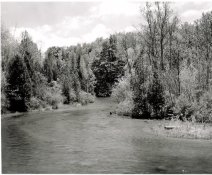I've tried to make sense of ilfords spectral graphs before and conlcuded that they're totally meaningless...
They're labelled as sensitivity, but are measured against tungsten... To me that makes no sense.
If it's a sensitivity then (to my understanding) it should be measured by firing unit energy (W/nm) of each frequency, and measuring the result, or if a particular light source is used, then it should be normalized post-measurement, so that the light source used is irrelevant.
Unless the results are normalized then the graph is a RESPONSE, rather than a sensitivity. You'd need to divide by the tungsten spectrum, then multiply by the daylight spectrum to get a daylight RESPONSE.
Even if they could decide what they're plotting, the y-axis label is dubious - it's labeled as 1.0 and 0.5 which sugguests it's linear, but log would be more appropriate (Kodak are much clearer in this respect).
Finally even if we could figure out what it's a graph OF it's way too small, and rough to be of any real use.
When choosing a filter we've got the kodak filter book which lists the spectral response numerically at 10 nm intervals, along with clearly labeled graphs. Unfortunatly that becomes virtually meaningless without the the equivalent data for the film.
I did some nice simulations of filters, surfaces and lights, but got could never find any film data to complete the system (I did email ilford, but got no response). If anyone has any good data for ANY film, I'd love to see it...
Ian











